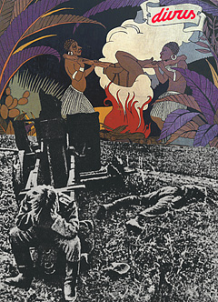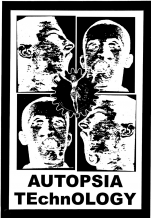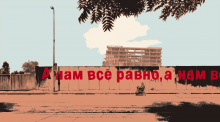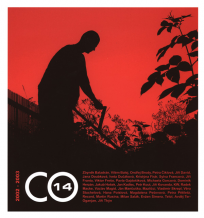| Umělec 2007/4 >> Strategy for a Functional Model tranzitdisplay – A Contemporary Art and Culture Project | Просмотр всех номеров | ||||||||||||
|
|||||||||||||
Strategy for a Functional Model tranzitdisplay – A Contemporary Art and Culture ProjectUmělec 2007/401.04.2007 Mariana Serranová | conceptual visions | en cs de es |
|||||||||||||
|
On November 9, 2007, Mexican artist Erick Beltrán’s exhibition opened as part of Display Gallery’s introduction to its new space on Dittrichova Street in Prague. Prior to that, Ján Mančušká gave a performance of Jestli je na mně něco dobrého, jsem to jen já, kdo to ví (If there’s something good about who I am, then it’s just me. Who knows?) at the Světozor Cinema. A week later, a lecture was given by Slavoj Žižek, today an oft-read political philosopher, in the new transitdisplay space.
The event also included the launch of his new Czech translation of Žižek’s book, Did Somebody Say Totalitarianism? This event-intensive launch demonstrates in principle how tranzitdisplay can function: in what areas, with what preferred usage, as well as what can be expected from this medium. Simply put, by including presentations by world-renowned artists and critics, facilitation of values expressing historical, social and political overlap, an international standard was defined. In the following text, I attempt to give an overview of certain culturally strategic premises for the use of tranzitdisplay as part of the creative scene. Identity and Authority tranzitdisplay is an influential alliance that, thanks to a stable financial structure and independence from any State structures, is able to generate a multi-tiered program. Such programs are more-or-less non-existent as far as profile and personnel structure types are concerned. Regardless of the unprecedented and generous financing model for tranzitdisplay activities (Erstebank Group and Česká spořitelna), its influence comes primarily from its internally-coherent concept and well-articulated program – these are otherwise conditions for the credibility of any type of formative authority. This rule draws attention to each exception in an environment such as ours. This holds even truer in environments where state-run institutions obviously miss out on the opportunity to serve as catalysts for continuous, well-thought-out, international communication. The general lack of respect for public officials and their inflated influence (The Czech National Gallery, etc.) speaks today, in a period where a balance statement for post-1989 transformation processes has already been made, to a number of symptomatic local determinants that have been strongly influenced by the ethics of power relations inside the artistic and political scenes. The biennial is a prime example of the current situation’s imbalance. Such events’ inescapably mass format and one-off commotion underscores the feeling that, as a result of dosages of foreign exhibits lacking concept, the fluidity of local operations has yet to reach a normal dynamic comparable to the level seen in “healthy” cultural centers. The clear disproportion comes from the fact that the omnipresent “obligatory” biennial was preceded by an evolution inclined toward a more structured artistic scene. The question is whether our globalized periphery will ever evolve to fit the model of the culturally-stratified “centre.” The systematic program of the activities of tranzit and Display that until now were independent of each other included the exceptions in the separation of powers on the domestic art scene (regardless of marked differences in their organizational structure). Both partners have a very noteworthy body of work behind them. This most likely could not have been done without their initiatives. Previous ad hoc co-operation and mutual support, which naturally stems from mutual appreciation and from the similar focus of both groups’ conceptual creation and orientation toward foreign audiences, turned into a partnership: the Czech cell of the international platform for Transit for Development in Central Europe joined forces with the main group in Vienna and the not-for-profit gallery, Display. Since 2002, the critic Vít Havránek has run the multi-tiered concept of tranzit in Prague (This includes development grants, residencies, presentation of Czech art abroad, publications, video projects, et. al.). The Display Gallery has, since its launch in 2001, run a number of events. These usually take place in the form of independent exhibits of one project (J. Dabering, S. Jansen, Oskar Dawicki, Olaf Breuning, Blue Noses; sub:label – Milena Dopitová, Jan Mančuška and others). The Display Gallery team is made up of theorists, David Kulhánek and Ondřej Chrobák, and artists, Zbyněk Baladrán and Tomáš Svoboda. In contrast to its previous, more modest address in Holešovice, its new space and greater financial support affords the gallery the possibility to organise even larger group exhibits. The addition of tranzitdisplay to the Prague artistic map of few active venues is seen by certain critics as abandoning diversity for a common agenda (i.e. as if 1+1=1 or even D + t = t; the low-budget Display Gallery allowed itself to be swallowed up by the richer transit program). Members of the tranzitdisplay platform underscore, however, that the original identities of transit and Display remain intact. They also believe that with pragmatic solidarity, both independent units can continue in their joint program and expand it. Perhaps one of the reasons why not everyone is supportive of the tranzitdisplay policy is its unprecedented model of functioning. This is one based on the support and initiative of banking groups, i.e. a standard tool of the system that, in the archaic and stereotyped imperative of institutional critics, represents capitalist domination. In other words, a force, whose influence artists are meant to fight against. Transit’s cultural policy – today the two-unit tranzitdisplay – offers a new institutional model. The subject of “institutional critique/criticism” changes together with the system. The way critique was traditionally understood in programs from the 1960s and 1970s in the West is now passé. Utopia and Manifest. The Past in the Present. The “mission statement” for tranzitdisplay’s solidarity took the form of a classic party platform statement. The common statement articulated via specific post-conceptual taxonomy moves along several lines. It is evident that the document is a carefully-constructed profile. tranzitdisplay’s joint manifesto includes several mutually-related themes that stand in contrast to other local movements. “The center of interest is research of the forms and content of contemporary works.” But at the same time this concerns specific forms and methods of realization: "participation," "a laboratory atmosphere“, "visible theoretic work," etc. Privileged forms such as participatory, relationship-focused, informative or inter-textual interpretation can generally be characterized as diverging from trends that are continually validated around the world. Tranzitdisplay acts in a selective way, choosing relevant work that is missing in the local environment. It favors materials that fit into a long-term concept, supporting work in the Czech Republic that can be viably presented on the international scene at representative events such as Documenta, etc. We now once again return to the issue: what about the sophisticated image of tranzitdisplay is irreplaceable and what, at the same time, bothers so many of its critics, specifically those who view the work as excessively one-sided? When people talk about the benefits of tranzitdisplay, most often they have in mind the fact that it attempts to bring Czech art into an international context. They also appreciate the fact that it supports contemporary work. But how does it do this? A constitutive pillar of the concept is that it attempts to systematically and contextually tie the past to the present, global trends to Czech trends, and with certain exaggeration – the artistic community to the societal reality. Vision means more than financial resources. tranzitdisplay’s joint manifesto is essentially, in and of itself, a reminder of all possible manifestos that have become part of history. The program rhetoric, an important allusion to (modernist) utopia, will uncover this conceptualisation of real, socio-political relationships. The presentation of artists such as Jiří Kovanda and Stano Filko, via their catalogues and exhibits, illustrates a fact confirmed long ago: the works of these two founders of the Czech and Slovak conceptual trends has a fundamental impact on a large portion of the current generation of twenty- and thirty-year-olds. Transit’s activities up to now, specifically developing a genealogy, shows how one can create an enduring and convincing vision – this is also the backbone of the transit and Display concept. The focus is on reviving old values that validate ties between current trends and that are strategically made visible (profiled) via transit. Today we are clearly aware that each time period continually reconstructs its own collective memory. Or rather society selectively constructs its own past, rather than wait for someone to recount it in a credible manner. We know that interpreting history based on the needs of the present is manipulative. When one speaks of the collective memory of Czech art, we also analogically reconstruct our artistic past per the needs of current trends. So let’s remember: what we create now will be recycled in the future (or perhaps not!). Places of Memory Transformation of cultural identity as part of the European's process of integration is taking place at all levels of society. It has had a specific influence on the mood of the local Czech art community. In fact, institutions that are trying here to adapt themselves to fit functioning European models are actually failing. Leftover mental waste from totalitarian regimes (in this case, Communism) has led both to intensified trauma as well as indecisive approaches to new challenges offered by unprecedented models. The repeated interruption of historical, or rather developmental, continuity in the 20th century and the lingering of its aftermath requires a permanent historical revision. Development over the past two decades inspired both in theory and in practice an interest in collective identity and memory. This mainly holds true in Central Europe, where the milestones of the 20th century were felt both strongly and traumatically. The monuments, after the period of total inflation of personal function during the totalitarian period, became nothing more than a prop in the hands of the government establishment. There are many monuments – whereas the psychological process of recollection is rather ephemeral. By addressing all this – the archaeo- logical method of uncovering layers of a stereotypically delivered topic – the initiative of Zbyněk Baladrán and Vít Havránek has developed a collaborative work. This effort has been growing since 2006 as a „work in progress“ thanks to the gradual collection of materials: the subjective testimonies of artists and theoreticians that have been asked to comment. The resulting archive does not collect just post-socialist experiences, but also memories from transitional periods in countries that joined the EU at a later date, for example, Greece and others. The Monument to Transformation sorts out the problems of recent history and the present (political changes in 1989-1968-2009), collective memory, and individual views in an intuitive way. Monuments, archives, databases or so-called „memory depositories“ hide that special cloud that is politics. Who leads recollection processes and to what end? Monuments and memorial services shape social relationships. In their own way they replace the natural environment that is the recollection process – but what happens when the monument is recollection itself? Does the relationship between memory and history not then return to its natural, or so to say, post-modern state? In addition to research on collective memory, tranzitdisplay also focuses its attention on „persons who have the need and strength to create subjective systems and their own universal models of the world. These attempts to a certain degree revive the utopian need to relate oneself to the world and its complexity: to a whole that the individual can embody (belong to) …“ What is discourse? The pilot exhibit by Eric Beltrán Ergo sum in the tranzitdisplay space represents a long-term project featuring archives adapted into the format of eponymous "newspapers" and space installations. Beltrán reflects upon power relationships that exist between the publication and construction of discussion. He focuses on mechanisms that "define, classifys, reproduce and distribute" images with the aim of creating economic and cultural discourse in contemporary society. This concerns mainly how the person of the editor defines our world and the power relationships between various groups. Here, I won’t go into the current theory of discourse as begun by its founders (Foucault, Althusser...) nor into the phenomenon of archives and databases as forms of arts. Rather I will limit myself to Beltrán’s approach. The starting point for the "catalogue work" Ergo sum is the question: what is discourse? It is a question that initiates a documentary process: how to organise thoughts. The most important part of any collection is not the elements, but rather how they interrelate and the inter-communication that is part of the thought chain. It’s not about amassing material but instead about the "process" of data collection. The resulting project captures this thought path in several layers that are systematically organized in a graphic display: via systems, diagrams, symbols, thematic lines, whose co-author is Eduardo Barrera. It took Erick Beltrán a full eight hours to explain, at a lecture the day after his exhibit opening, the relationships and ties between individual "complexes" included in the construction of the peculiar universe in the Ergo sum project. The open process of organic evolution serves as a parallel for him – please forgive me for not discussing it in detail as should be, and as deserves to be, done. Beltrán compares his long-term project Ergo sum, a project that addresses the problem of archiving and documentation, to a Rubik’s Cube. According to him, research has proven to be some sort of running "machine" that generates more and more combinations. It is a subjective method dependent on intuition, chance and other similar factors. Based on research and sorting of materials that travel through the systems of information reproduction and distribution (texts, images, photos, print, serigraphy, media, internet ...), he discovered that people are basically very monothematic. Through his adventurous research he discovered a certain type of more generally valid figures – certain archetypes. The surfacing of these archetypes brought him to the conclusion that the criteria, like/dislike, that is criteria based on natural impulses, generate clear paths (lines) that fall under the category of "patrons." Something that is individually constitutive. An apparent paradoxical finding from this method is that the more material one gathers, the clearer these primary, main themes and paths appear. Models and Systems The Utopian aspect of Western history is the moment when participation in the collective process of material production is understood to be something that can create an authentic sense of community and solidarity. This also holds true for stimulating projects that only a small portion of the community is excited about. In reality, they appear to be a “phantasmal structure of discourse practices in a completely unpredictable system” (Žižek). Any effort to understand this system appears to be a modern, perhaps even “romanticized” utopia. Awareness of this unclear complexity prompts one to seek out endless connecting relationships, ergo the more material you collect, the clearer a certain, basic, main theme becomes (Beltrán). Instead of one-sided criticism focused on one isolated problem, or instead of specifically limiting oneself to focus on a current, frustrating state of affairs, tranzitdisplay offers a specific alternative for how to survive in the system. This type of functional model shows that “the system” cannot be circumvented; rather one must communicate with the system. After all, from its position of peculiar authority, it has a tendency to reduce the ideas and values from which it derives its legitimacy. Relationships in the current system are very complex. The idea of a traditionally-conceived hierarchy can no longer describe the current state in all its aspects. Rather it is a fluid reflex of complicated relationships and dialogues, orienting themselves within the system, using its dominance and conceptualizing its mechanisms. According to Chantal Mouffe it is desirable that “artistic practices contribute to the struggle against capitalist domination.” However, according to her, this requires acknowledging the political in its antagonistic dimension.” In her view, politics and art are not two separate entities, between which it is necessary to build a relationship, but: “there is an aesthetic dimension in the political and there is a political dimension in art.”6 The tranzitdisplay manifesto explains why the values are important and which principles the program looks to embody: “We are interested in art as contemporary practice, which mobilizes the social space and interpersonal relationships, produces its own sensibility to matters of political nature.” I haven’t the faintest idea how to view reciprocity between platforms focused on art and those of banking groups investing in art. I only dare guess that even these relationships are guided by the ever-present laws of unpredictability. So one should move beyond the paranoid idea that banks are not concerned about their image, but that instead—as part of their social monitoring—the establishment of a second experimental laboratory, where they can research what this or that person thinks about the world and about life. In any case, the result of this anomaly is a uniquely coordinated service for cultural activities within the system. The tranzitdisplay program, and artistic projects that it presents, ultimately reflect these relationships and internal processes. In the end it appears that the apparent utopianism in the tranzitdisplay manifesto is the message of a “model” that is “more real” than any other we know. Eventual criticism of the tranzitdisplay platform’s sober positions, whether declared or simply expected, would call for the construction of another cohesive system on how to survive within the system. The label “elitist” applied to tranzitdisplay is legitimized by the fact that the group can hold its own in defending the quality of its product. Besides strategically drawing from older values and linkage to the international art scene, the platform maintains a systematized concept – compliance between its own theory and practice. From the point of view of theoretical superstructures, we have set high goals for ourselves. The realization of a broad vision is not easy. Our definition is quality – this applies most of all in this limited environment where there are few such high-profile platforms. tranzitdisplay’s cautious strategy, when liberated from its heavy burdens, shows how it is possible to move along the landscape of real problems in their real contexts. Ultimately, we are primarily interested in projects that are of good quality that support the process of our local de-stigmatization: by means of surveys, research, discourse analysis, and the archaeology of memory. In its existence alone, tranzitdisplay is, by definition, a model that is beneficial not only in that it has developed visual literacy toward non-traditional types of art, but also in that it supports literacy of the system’s mechanisms. This is important regardless of whether one likes the system or not.
01.04.2007
Рекомендуемые статьи
|
|||||||||||||
|
04.02.2020 10:17
Letošní 50. ročník Art Basel přilákal celkem 93 000 návštěvníků a sběratelů z 80 zemí světa. 290 prémiových galerií představilo umělecká díla od počátku 20. století až po současnost. Hlavní sektor přehlídky, tradičně v prvním patře výstavního prostoru, představil 232 předních galerií z celého světa nabízející umění nejvyšší kvality. Veletrh ukázal vzestupný trend prodeje prostřednictvím galerií jak soukromým sbírkám, tak i institucím. Kromě hlavního veletrhu stály za návštěvu i ty přidružené: Volta, Liste a Photo Basel, k tomu doprovodné programy a výstavy v místních institucích, které kvalitou daleko přesahují hranice města tj. Kunsthalle Basel, Kunstmuseum, Tinguely muzeum nebo Fondation Beyeler.
|


































 We Are Rising National Gallery For You! Go to Kyjov by Krásná Lípa no.37.
We Are Rising National Gallery For You! Go to Kyjov by Krásná Lípa no.37.
Комментарии
Статья не была прокомментированаДобавить новый комментарий